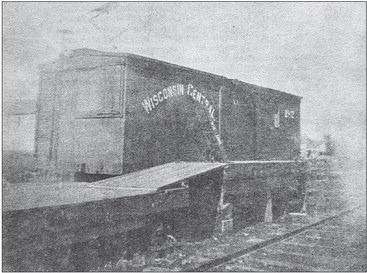As with many lands in ….


As with many lands in Wisconsin, the earliest settlers of the region can be traced back to Native American tribes. Dorchester was ranged by the Chippewa, Dakota, Winnebago and Menominee Indian tribes. During the treaty of 1825, the county was parceled three ways with one parcel going to the Winnebago tribe, another to the Chippewa and the third was to remain neutral land.
French fur traders traveled through the area, followed by missionaries and eventually, the first permanent settlers came to Clark County in 1839. In 1873, all tribal claim to Clark County was relinquished.
In April of 1873, Boyle and Seymour Construction Company started laying rail at Colby and proceeded north. The railway ran through what is now presently Dorchester Station No. 59 was placed along the line, making it the first structure in Dorchester. The station was joined by a section house, side track, turntable and a few other buildings.
A settlement had formed a mile and a half north of what is now Dorchester. A small grocery store was erected, but soon after, the settlement moved south where a small sawmill had been built in the spring. The mill became the main source of industry for the settlement as people came to work at the mill.
According to accounts from the time, the mill gave workers one board each day along with the worker’s wages to help settlers frame their homes.
Two of the first buildings in Dorchester were a mercantile store built by Dan O. Miltimore and Hugoboom’s Central House Hotel. Seven years later, five more merchandise stores had gone up and Dorchester became a budding hub.
The earliest families making Dorchester their home was Alfred Hunt in 1874, Edward Benson, John Lansworth and Daniel Miltimore in 1875 and Augustus Homsted in 1882.
Naming of Dorchester
An excerpt from the Dorchester centennial book.
“In Southwest England near the coast in Dorset County, there is a town tracing its history to the Romans, called Dorchester. Settlers from there voyaged to the new world to settle in Massachusetts in the 1660’s. Typically, the settlers named their new home after their homeland– thus, Dorchester, Mass., now a section of the city of Boston.
“The Dorchester name traveled west to Wisconsin with Charles L. Colby and the arrival of the Wisconsin Central Railway Company to the Dorchester site in 1873. Charles L. Colby was the son of the president, Gardner Colby; and a partner in the Phillips & Colby Construction Company of Boston, Mass. He reached this area while clearing the right-ofway for the tracks from Menasha to Ashland in the early 1870s. Many of the new towns along the Wisconsin Central Railway Line were named after towns with similar names in Massachusetts.”
The first pioneers in central Wisconsin arrived on foot, or came by way of a team of oxen. The journey took as long as three weeks as settlers came from Milwaukee. Pioneers cut their own roads through the timber in order to reach the land that they purchased.
The clearing of land was done by hand or by an ox. The first homes and barns were made of logs or sod. Pioneers got materials by walking on trails through the wilderness to nearby towns and returning with them on their backs. The journey was dangerous but needed. Resident Andrew Sorenson said they built beds out of pine boards and used mattresses filled with hay. They made their own chairs and benches and made tables out of pine boards as well. All was homemade except the stove which was brought from Oconomowoc.
All information was obtained using entries from the Dorchester Centennial book as well as entries from the Dorchester Historical Society.

